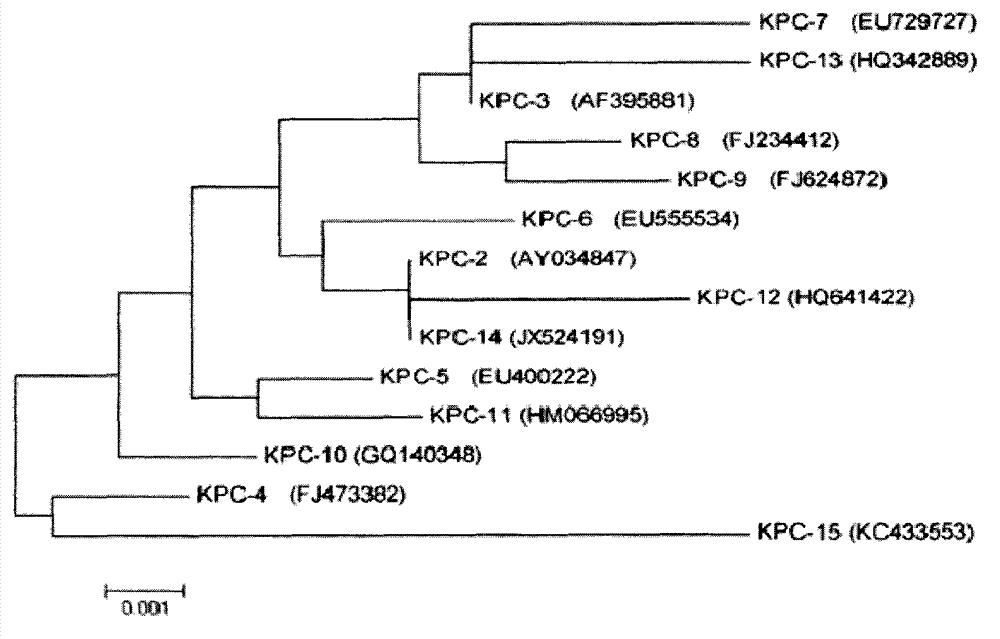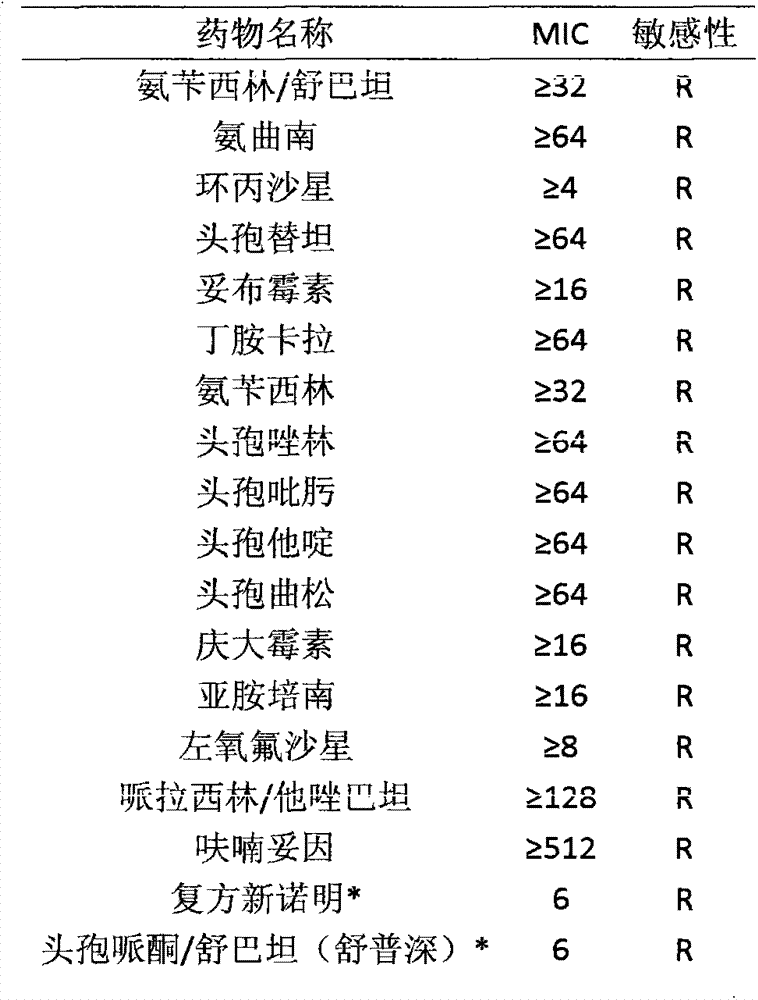PCR kit for detecting Klebsiella pneumonia containing KPC-15 gene
A technology of KPC-15 and detection kit, applied to Klebsiella pneumoniae clinical drug-resistant strains, Klebsiella pneumoniae clinical drug-resistant strains carry the new drug-resistant gene KPC-15, and detect the KPC-15 gene carrying KPC-15 In the field of PCR detection, it can solve problems such as the threat of using carbapenem antibiotics to treat Enterobacteriaceae bacterial infections
- Summary
- Abstract
- Description
- Claims
- Application Information
AI Technical Summary
Problems solved by technology
Method used
Image
Examples
Embodiment 1
[0029] Example 1 Drug susceptibility detection of Klebsiella pneumoniae clinical drug-resistant bacteria KP1241
[0030] Klebsiella pneumoniae clinical drug-resistant bacteria KP1241 was isolated from the blood culture specimens of patients in the Department of Cardiothoracic Surgery of Taizhou Municipal Hospital. The strain showed resistance to imipenem and ertapenem, and was identified as Klebsiella pneumoniae by the VITEK2Compact automatic bacterial identification and drug susceptibility analyzer of BioMérieux, France, and was numbered KP1241.
[0031] 1. Materials and methods
[0032] VITEK2Compact automatic bacterial identification and drug susceptibility analyzer of French bioMérieux company; bacterial identification card: VITEK2GN Test kit;
[0033] Bacterial susceptibility card: AST-GN13 from bio Merieux, France. AST-GN13 drug-sensitive types include: amikacin, ampicillin, ampicillin / sulbactam, aztreonam, cefazolin, cefepime, cefotetan, ceftazidime, ceftriaxone, cipr...
Embodiment 2
[0045] Example 2 Calling and sequencing of KPC gene
[0046] 1. Materials and methods
[0047] Plasmid extraction: Plasmids were extracted using miniBEST plasmid purification Kit from TakaRa Company. The specific steps of plasmid extraction were carried out according to the instructions, and finally the final concentration of the extracted plasmid was quantified as 1ug / uL.
[0048] Amplification of KPC gene: According to NCBI data, design the amplification primers of KPC gene, the sequence is as follows:
[0049] KPC-15PCR primer: (PCR primer)
[0050] KPC-15PF: 5'-CGAGCAACTATGGATGAACG-3' (SEQ ID NO.3)
[0051] KPC-15PR: 5'-GTATCTGTGAGGGCGAAGG-3' (SEQ ID NO.4)
[0052] The amount of each component in the PCR amplification is: 0.5 μL each of the upstream primer and the downstream primer; no Mg 2+ buffer 2.5 μL; high-fidelity DNA polymerase 0.25 μL with a concentration of 5 U / μL; dNTPs 2 μL; MgCl 2 1 μL; deionized water 17.75 μL; plasmid 1.5 μL. PCR amplification conditio...
Embodiment 3
[0058] Example three plasmid transduction test
[0059] The donor bacterium is the KP1241 strain, and the recipient bacterium is E.coli J53AzR (resistance to sodium azide). The donor bacteria and recipient bacteria were inoculated on LB plates, respectively, and cultured overnight at 35°C. Pick a single colony and inoculate them in 4 mL of LB broth, and culture at 37°C and 220 r / min until the logarithmic growth phase. Take 0.5ml of donor and recipient bacteria in 4ml of LB broth, and culture overnight at 37°C. Zygotes were screened on trypan soy agar (TSA) plates containing sodium azide (300 mg / L) and ciprofloxacin (0.03 mg / L). Incubate at 35°C for 18-24 hours. The KPC-15 gene detection was performed on the screened zygotes by PCR method, and the positive ones were re-identified as Escherichia coli, which indicated that the conjugative transfer of the drug-resistant plasmid carrying the KPC-15 gene was successful.
[0060] KPC-15 and E.coli J53Az R All drug-sensitive (dru...
PUM
 Login to View More
Login to View More Abstract
Description
Claims
Application Information
 Login to View More
Login to View More - R&D
- Intellectual Property
- Life Sciences
- Materials
- Tech Scout
- Unparalleled Data Quality
- Higher Quality Content
- 60% Fewer Hallucinations
Browse by: Latest US Patents, China's latest patents, Technical Efficacy Thesaurus, Application Domain, Technology Topic, Popular Technical Reports.
© 2025 PatSnap. All rights reserved.Legal|Privacy policy|Modern Slavery Act Transparency Statement|Sitemap|About US| Contact US: help@patsnap.com



